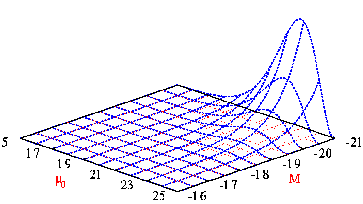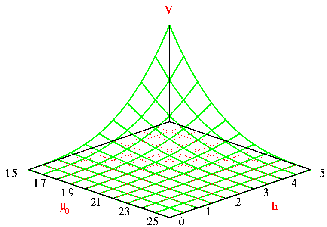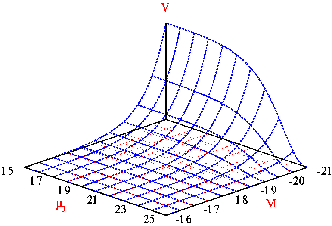


6.3.1. Diameter-limited Catalogs
The two selection parameters which need to be specified for a galaxy
catalog selected by diameter are the diameter limit
 l
and the isophotal level µl at which the diameter
is measured.
To show these it is only necessary to calculate the relative
volume sampled as a function of the disk parameters, so the explicit
value of
l
and the isophotal level µl at which the diameter
is measured.
To show these it is only necessary to calculate the relative
volume sampled as a function of the disk parameters, so the explicit
value of  l is irrelevant.
DP derive the visibility as a function of surface
brightness at fixed luminosity, then state that this can be scaled by
luminosity (i.e., V
l is irrelevant.
DP derive the visibility as a function of surface
brightness at fixed luminosity, then state that this can be scaled by
luminosity (i.e., V
 L3/2). For
a diameter limited catalog,
they find that the volume sampled goes as
L3/2). For
a diameter limited catalog,
they find that the volume sampled goes as

| (13) |
at fixed luminosity (see their equation 31). In order to show the full functional dependence on two parameters which describe the disk, we scale by luminosity as they suggest, arbitrarily normalized at M* = -21 as they chose to do. Their full visibility, including the effects of both central surface brightness and absolute magnitude, is thus

| (14) |
This is shown in Fig. 6-5 for the case µl = 25 mag arcsec-2.

|
Figure 6-5: |
The DP visibility function has a broad peak which
always occurs at µ0 =
µl -
2.17. For the case of
µl
= 24.0, this peak would occur at µ0 = 21.8. If
there is an intrinsic
distribution  (M,
µ0) which populates a range of
µ0 as
well as M, then the visibility function will cause catalogs to
preferentially sample galaxies with µ0 near this
peak. That this is very close to the Freeman
value is the root of Disney's argument. However, a robust prediction
of the DP visibility formalism is that the central surface brightness
typically found in diameter limited surveys will grow fainter as surveys
are pushed deeper. Contrary to this expectation, the peak in the
apparent distribution is observed not to vary with
µl
(Phillipps et al. 1987), leading some to conclude that surface brightness
selection effects are not important (van der Kruit 1987). Also,
as noted by DP, the peak is too broad to explain the narrow
observed distribution.
(M,
µ0) which populates a range of
µ0 as
well as M, then the visibility function will cause catalogs to
preferentially sample galaxies with µ0 near this
peak. That this is very close to the Freeman
value is the root of Disney's argument. However, a robust prediction
of the DP visibility formalism is that the central surface brightness
typically found in diameter limited surveys will grow fainter as surveys
are pushed deeper. Contrary to this expectation, the peak in the
apparent distribution is observed not to vary with
µl
(Phillipps et al. 1987), leading some to conclude that surface brightness
selection effects are not important (van der Kruit 1987). Also,
as noted by DP, the peak is too broad to explain the narrow
observed distribution.
An alternative derivation of these effects can be done as follows.
For diameter
limited surveys, the requirement is that
 = 2r
= 2r

 l
when µ(r) =
µl. From equation 5 it follows that
l
when µ(r) =
µl. From equation 5 it follows that

| (15) |
The maximum distance at which a galaxy can lie and meet the selection criteria
occurs when  =
=
 l, so
l, so

| (16a) |
For arbitrary  l the
relative volume sampled
V
l the
relative volume sampled
V  dmax3 is
dmax3 is

| (16b) |
This is plotted in Figure 6-6.

|
Figure 6-6: |
There is a very significant difference between
Figures 6-5 and 6-6
(and between Figures 6.7 and
6.8).
The "visibility" in Fig. 6-5 does not have
a peak at some preferred surface brightness, but increases without bound
as µ0 becomes brighter. In contrast,
Figure 6-6
shows the variation
of V with µ0 is extremely rapid, so we
expect that the
apparent surface brightness distribution should always be very strongly
peaked around the brightest value which exists in the intrinsic
distribution, regardless of the value of
µl.
In this treatment, galaxy size and surface brightness are orthogonal
properties of a galaxy for purposes of selection, and it is really
necessary to consider their separate effects fully. For instance,
very luminous
galaxies can be missed if their central surface brightness is very low.
To date, available data strongly show that µ0 and
 l are uncorrelated
(see Figure 6-14).
l are uncorrelated
(see Figure 6-14).

|
Figure 6-7: |
Mathematically, one can use equation transfrom
 l in equation 16b
with M to recover equation 14. While algebraically correct,
this makes little physical sense. Absolute magnitude and central
surface brightness are not independent quantities, so the axes of
Fig. 6-5 have a high degree of
covariance. This is the reason
that this representation of the selection effect in this manner is so
misleading.
In order to keep M
fixed as µ0 varies, it is necessary to also change
l in equation 16b
with M to recover equation 14. While algebraically correct,
this makes little physical sense. Absolute magnitude and central
surface brightness are not independent quantities, so the axes of
Fig. 6-5 have a high degree of
covariance. This is the reason
that this representation of the selection effect in this manner is so
misleading.
In order to keep M
fixed as µ0 varies, it is necessary to also change
 l. This
is unphysical. At issue is how any given galaxy will be selected.
Imagine a galaxy of scale length
l. This
is unphysical. At issue is how any given galaxy will be selected.
Imagine a galaxy of scale length
 l.
As µ0 varies, M varies with it
but
l.
As µ0 varies, M varies with it
but  l remains
fixed. In order to also hold M fixed we must
alter the size of the object so that it is no longer the
same object. In this sense, the characteristic size and surface
brightness of a galaxy are more fundamental properties that its
luminosity, a quantity which loses information by lumping together
these two distinct pieces of information (through equation 11)
in a degenerate manner.
l remains
fixed. In order to also hold M fixed we must
alter the size of the object so that it is no longer the
same object. In this sense, the characteristic size and surface
brightness of a galaxy are more fundamental properties that its
luminosity, a quantity which loses information by lumping together
these two distinct pieces of information (through equation 11)
in a degenerate manner.